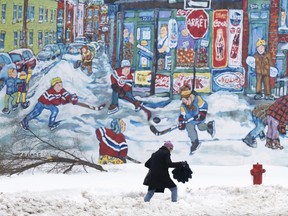Winter was cancelled in Canada last year, but there is a major cold snap coming that will extend almost all the way to Mexico

The intense cold snap about to settle over most of Canada and the U.S. has been dubbed a “polar vortex’, but Environment Canada Senior Climatologist David Phillips says it could just as easily be called “Arctic air or Siberian air.”
Recommended Videos
In the present instance, Siberia is where the cold air is originating, so Siberian air is his choice.
We will be momentarily seduced by a few warm-ish days before it descends, but this “bully of winter” will come in as “very thick air, settle in every nook and cranny and be tough to dislodge,” says Phillips.
It will be too thick to cross the Rockies into B.C. or the ocean to hit Newfoundland. So, those parts of Canada will be spared the worst of it, he says.
It won’t be record cold, he says, but this cold snap is going to extend down through the U.S. almost to Mexico.
We had a brief cold snap before the holidays, bringing us a white Christmas, but then things warmed up. “It’s cruel in a way,” says Phillips.
How will this cold snap descend across Canada?
It will hit the Prairies first — throughout the weekend, says Phillips. Central Canada will be hit early next week. For example, 0 degrees Celsius on Friday in Montreal will be followed by -24 C on Monday.
Cities that are normally colder, such as Ottawa and Winnipeg, will feel deceptively warm before the temperature sinks. Calgary, for example will drop to -22 C on the weekend before it hits 7 C on Thursday, “almost like a Chinook.”
Wherever you are when it hits, Canadians are warned to be keenly aware of frostbite. It can hit exposed bits of your body within 20 minutes of going outside.
All of this stands in stark contrast to last winter. “It was as though winter was cancelled last year,” says Phillips, pointing to the impact of El Niño, the natural climate pattern that occurs when the surface of the central and eastern part of the tropical Pacific Ocean warms.

Why is it called the ‘dead of winter’?
Irrespective of changing patterns, mid to late January is always known as “the dead of winter,” says Phillips. Looking to 30 years of temperature statistics in Canada, the high for the year is usually around July 20, while the low comes any time now.
And Canada is the second coldest country in the world after Russia. However, he says, there’s no need to despair.
“It’s a time to celebrate. It’s great for the skiers and ice fishermen. This year, the entire Rideau Canal is open for skating after two years of going without. There’s also the Quebec Carnival.”
It’s a great time for evening, winter walks. “You can embrace the cold crunching sound of the snow.”
Last winter, when it was mild, Canadians were confused, he says. Sure, we saved on home-heating bills, but retailers missed out on sales of boots and parkas.
Where do terms like polar vortex come from?
The notion of naming a cold snap the “polar vortex” equates with calling intense rain in B.C. an “atmospheric river” or talking about “weather bombs,” says Phillips.
“We like to embellish our weather stories.”
With the spectre of climate change entering public discourse, people wonder about perceived extremes, says Sandi Duncan, editor of the Farmers’ Almanac, the magazine that has been providing winter weather predictions since 1818.
This year’s Almanac extended forecast for Canada states that “the winter of 2024-25 should see below-normal temperatures for about two-thirds of the nation, from east of the Rockies to Ontario. Winter temperatures will be coldest from the Prairies into the Great Lakes region.”
Duncan confesses the Almanac prediction of frigid temperatures for “the final week of January into the beginning of February” is a little off but, it’s close. (And, anyway, who among us thinks of weather-predicting as an exact science?)

Is this cold any different than in our parents’ day?
It’s still “the same cold that our parents and grandparents had to deal with.” (Note, Phillips is 80 years old.)
This type of cold generally sits in higher levels of the earth’s atmosphere, he explains, but then is nudged to the surface and spread by strong winds.
The present cold snap will make for a very chilly presidential inauguration day, south of the border, notes Phillips. The Americans will want to “blame Canada” but Phillips reasserts: It’s not us, it’s Siberia.
Meanwhile, Duncan offers some tips: pack an extra pair of socks and mittens in your car; leave your cupboard doors open so indoor heating can help keep your pipes from freezing; and, be sure to bring your pets inside. Finally, be a good neighbour. Check on nearby folks who are elderly or disabled.
“The good news,” she says, “is that after this cold snap, it’ll warm up a little.”
Our website is the place for the latest breaking news, exclusive scoops, longreads and provocative commentary. Please bookmark nationalpost.com and sign up for our daily newsletter, Posted, here.